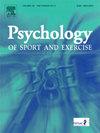Burnout trajectories among adolescent student-athletes: The role of gender, success expectations, and parental affection
IF 3.1
2区 心理学
Q2 HOSPITALITY, LEISURE, SPORT & TOURISM
引用次数: 0
Abstract
In this longitudinal study, we examined the trajectories of sport and school burnout symptoms (exhaustion, cynicism, inadequacy) during the transition to lower secondary sport school among Norwegian student-athletes aged 13–14 years (n = 265; 58,5% males, 41,5% females). We also investigated how student-athletes’ gender and individual success expectations, and their parents' reported levels of affection and success expectations, were associated with different burnout trajectories. Student-athletes completed associated questionnaires at the beginning and end of the first school year, while parents completed questionnaires at the end of the school year. Linear mixed models showed that sport and school burnout symptoms increased over the school year. Females reported higher baseline levels of sport burnout, and males lower baseline levels of school burnout. Low individual success expectations were associated with higher baseline levels of sport and school burnout, and increase in school burnout symptoms over time. High parental success expectations were associated with lower baseline levels of school-related exhaustion. Sport inadequacy increased for student-athletes whose parents reported either affection levels and success expectations that were either both high or both low. The results suggest that it is important that sport schools take the dual pressure student-athletes may experience into consideration, and provide them with adequate support during the transition to lower secondary education. In addition, interventions aimed at increasing parental knowledge of beneficial and harmful ways of involvement in student-athletes’ lives are needed to facilitate student-athlete wellbeing.
青少年学生运动员的职业倦怠轨迹:性别、成功期望和父母情感的作用。
在这项纵向研究中,我们考察了13-14岁挪威学生运动员在向初中体育学校过渡期间的运动和学校倦怠症状(疲惫、玩世不恭、不足)的轨迹(n = 265;男性58.5%,女性41.5%)。我们还调查了学生运动员的性别和个人成功期望,以及他们的父母报告的情感水平和成功期望,如何与不同的倦怠轨迹相关。学生运动员在第一学年开始和结束时完成相关问卷,而家长在学年结束时完成问卷。线性混合模型显示,运动和学校倦怠症状随着学年的增加而增加。女性报告的运动倦怠基线水平较高,而男性报告的学业倦怠基线水平较低。较低的个人成功期望与较高的运动和学校倦怠基线水平有关,并且随着时间的推移,学校倦怠症状也会增加。父母对成功的期望越高,与学校相关的疲劳基线水平越低。父母报告的情感水平和成功期望要么高要么低的学生运动员,运动不足的情况有所增加。研究结果表明,体校应充分考虑学生运动员可能面临的双重压力,并在他们向初中教育过渡的过程中提供足够的支持。此外,为了促进学生运动员的健康,需要采取干预措施,增加家长对参与学生运动员生活的有益和有害方式的了解。
本文章由计算机程序翻译,如有差异,请以英文原文为准。
求助全文
约1分钟内获得全文
求助全文
来源期刊
CiteScore
6.40
自引率
5.90%
发文量
172
审稿时长
69 days
期刊介绍:
Psychology of Sport and Exercise is an international forum for scholarly reports in the psychology of sport and exercise, broadly defined. The journal is open to the use of diverse methodological approaches. Manuscripts that will be considered for publication will present results from high quality empirical research, systematic reviews, meta-analyses, commentaries concerning already published PSE papers or topics of general interest for PSE readers, protocol papers for trials, and reports of professional practice (which will need to demonstrate academic rigour and go beyond mere description). The CONSORT guidelines consort-statement need to be followed for protocol papers for trials; authors should present a flow diagramme and attach with their cover letter the CONSORT checklist. For meta-analysis, the PRISMA prisma-statement guidelines should be followed; authors should present a flow diagramme and attach with their cover letter the PRISMA checklist. For systematic reviews it is recommended that the PRISMA guidelines are followed, although it is not compulsory. Authors interested in submitting replications of published studies need to contact the Editors-in-Chief before they start their replication. We are not interested in manuscripts that aim to test the psychometric properties of an existing scale from English to another language, unless new validation methods are used which address previously unanswered research questions.

 求助内容:
求助内容: 应助结果提醒方式:
应助结果提醒方式:


